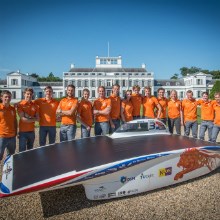The NUON Solar Team has arrived in the tropical city of Darwin, Australia to prepare for the Bridgestone World Solar Challenge starting on the 18th of October. In the past months the 15 students of the Dutch team from the Delft University of Technology have developed, tested and built the Nuna8 solar car. Lighter than its predecessor and with improved aerodynamics, Nuna8 is designed to defend their world title! The team uses two of our new SMP10 smart pyranometers in preparation and during the race.
The weather in Darwin is as expected for a solar race; over 35 degrees during the day with bright sunshine, cooling down to 25 degrees at night. During the race the temperature will first increase when they move South through Australia and then drop to an expected 15-20 degrees on arrival in Adelaide.
Trip ‘up’ from Adelaide to Darwin
Recent weeks have passed so quickly for the team: three weeks ago they packed the flight case with Nuna8 and two weeks ago they flew to Australia. In the past week they have made the trip ‘up’ from Adelaide to Darwin, to prepare the convoy and experience the route the other way around. This boosted the team spirit and everybody is ready to kick ass in the race!
During the trip up, the SMP10 pyranometers have been out of the box already. “We have collected a morning and night of data in the middle of the desert.” says Emiel Lorist responsible for Strategy & Finance. “One of the pyranometers was positioned horizontally and the other one pointed at the sun. This provided valuable information on the input of our PV panel during the race. The Nuna8 stands still from 5:00 pm to the next morning at 8:00 am and that’s the time when we position our panel towards the sun. The weather forecast however only provides the horizontal solar irradiance. During the day the difference between horizontal radiation and the incoming radiation from the sun a relatively easy sinus calculation. But, in the early morning and evening the radiation has to travel a longer path through the atmosphere before it reaches the surface and that complicates things. To study this connection we have collected valuable data with the SMP10 pyranometers.”
You can read more how the team uses the pyranometers during the race, and after the hoped for victory, in October. Good luck in the race, Nuna8!





